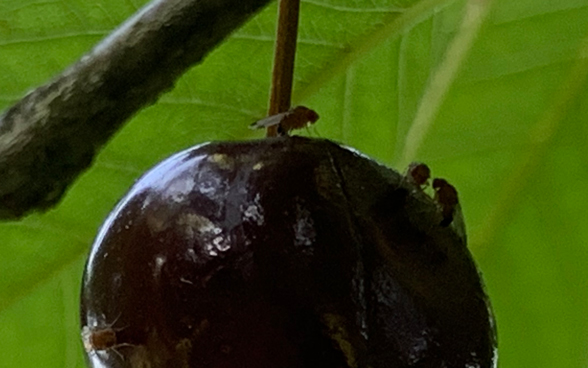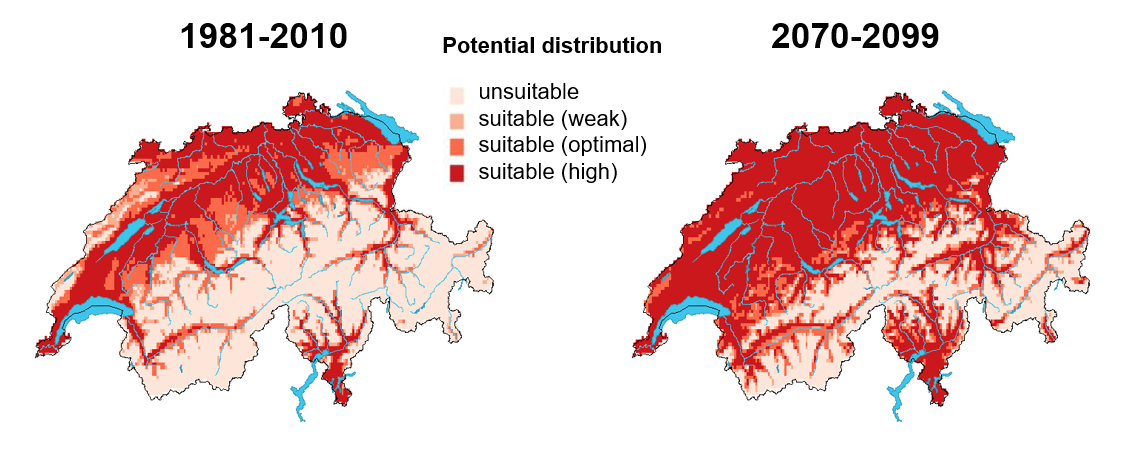The spotted wing drosophila (Drosophila suzukii) Matsumura (Diptera: Drosophilidae) (Figure 1) originates from Southeast Asia and was first detected in the USA (California) and Southern Europe (Italy, Spain) in 2008 (Asplen et al. 2015). In Switzerland it was found for the first time in July 2011 on blueberries in the Canton of Ticino and on raspberries in the Canton of Grisons (Baroffio and Fischer 2011). The spotted wing drosophila is now one of the most important invasive pests of stone and soft fruit and individual grape varieties. The reasons for this are numerous. The spotted wing drosophila can infest a large number of cultivated soft fruits (berries, cherries, plums, grapes) and also wild berry plants (blackberries, red elderberries, cornelian cherry, dogwood) (Kenis et al. 2016; Lee et al. 2015). With its serrated ovipositor, the female pierce the skin of intact ripening fruits to lay eggs in them. The spotted wing drosophila can reproduce enormously fast at favourable temperature conditions between 20°C-25°C. The development from egg to adult fly then takes only 8-14 days (Tochen et al. 2014). In Central Europe, up to 8 generations per year can therefore be expected (average: 4-5). Several days with a temperature below 10°C and an air humidity below 70% directly influence the further development and reproduction and can delay the population growth of the spotted wing drosophila. Under unfavourable climatic conditions, the spotted wing drosophila can also retreat into hedges or forests.

© FiBL, S. Stöckli
In Switzerland, numerous possible solutions were examined in collaboration with cantonal authorities and practitioners and information sheets were produced within the national «task force drosophila» and individual research projects:
- Agroscope - Drosophila suzukii
- BIOAktuell - Drosophila suzukii
- FiBl - InvaProtect
- Cabi - Biological control of the Spotted wing Drosophila - Drosophila suzukii
- zhaw - Automated Airborne Pest Monitoring AAPM of Drosophila suzukii in Crops and Natural Habitats
In order to manage the spotted wing drosophila sustainably, an integrated strategy considering various measures is necessary. A risk assessment using trap monitoring or checking fruits for oviposition marks is essential as a basis for decision-making. Population models or decision support systems can support a risk assessment. Such simulation models are currently being developed by various research institutions (Wiman et al. 2014; Wiman et al. 2016; Gutierrez et al. 2016; Langille et al. 2016; Ørsted and Ørsted 2019); Website SIMKEF). Recommended preventive control measures comprise a dry stand climate, early and fast harvesting or regular removing overripe and damaged fruit or netting. Intensive research is also being conducted into the use of natural antagonists. Mineral products such as kaolin or lime deters egg-laying. Many experiments have also been conducted in recent years on the effectiveness of insecticides. If population models are combined with climate scenarios, the consequences of climate change on the distribution and seasonal phenology of harmful organisms can be estimated. Such climate impact studies are the basis for possible adaptation measures in plant protection.
The potential distribution and seasonal occurrence of the spotted wing drosophila under present and future climatic conditions were estimated bioclimatically using the CLIMEX model (Kriticos et al. 2015). The simulated current potential distribution area in Asia, America and Europe corresponds very well with the observed occurrence of the spotted wing drosophila. For North America and Canada, climate models have shown that the growth potential of the spotted wing drosophila could decrease in the central regions of the USA because summer temperatures are likely to be too high for a long period of time (Langille et al. 2017). On the other hand, the trend for northern central areas in Canada shows a higher bioclimatic suitability for the longer-term survival of the spotted wing drosophila. The reason for this trend is mainly due to milder winter temperatures.
According to our simulation with the bioclimatic model CLIMEX and the climate scenarios for Switzerland, the distribution area of the spotted wing drosophila is likely to expand into higher-lying fruit growing areas in the future (Figure 2). The proportion of land in Switzerland that is bioclimatically suitable for long-term survival could double. The results show that the growth potential in the Swiss Central Plateau could increase strongly and the period of activity could be extended. In individual weeks in the future, more heat or drought stress can be expected for the spotted wing drosophila. However, these short phases are unlikely to affect the longer-term survival of the spotted wing drosophila in Switzerland's regions.
Additional Information
Literature
Asplen MK, Anfora G, Biondi A, Choi D-S, Chu D, Daane KM, Gibert P, Gutierrez AP, Hoelmer KA, Hutchison WD, Isaacs R, Jiang Z-L, ti ZKr, Kimura MT, Pascual M, Philips CR, Plantamp C, Ponti L, Ve´tek1 Gb, Vogt H, Walton VM, Yu Y, Zappala L, Desneux N (2015) Invasion biology of spotted wing Drosophila (Drosophila suzukii): a global perspective and future priorities. J Pest Sci 88:469-494
Baroffio C, Fischer S (2011) Neue Bedrohung für Obstplantagen und Beerenpflanzen: Die Kirschessigfliege. UFA-Revue 11:46-47
Gutierrez A-P, Ponti L, Dalton DT (2016) Analysis of the invasiveness of spotted wing Drosophila (Drosophila suzukii) in North America, Europe, and the Mediterranean Basin. Biol Invasions: DOI: 10.1007/s10530-10016-11255-10536
Kenis M, Tonina L, Eschen R, van der Sluis B, Sancassani M, Mori N, Haye T, Helsen H (2016) Non-crop plants used as hosts by Drosophila suzukii in Europe. J Pest Sci:DOI 10.1007/s10340-10016-10755-10346
Kriticos DJ, Maywald GF, Yonow T, Zurcher EJ, Hermann NI, Sutherst RW (2015) CLIMEX Version 4: Exploring the effects of climate on plants, animals and diseaes. CSIRO, Canberra
Langille AB, Arteca EM, Newman JA (2017) The impacts of climate change on the abundance and distribution of the spotted wing drosophila (Drosophila suzukii) in the United States and Canada. Peerj 5. doi:10.7717/peerj.3192
Langille AB, Arteca EM, Ryan GD, Emiljanowicz LM, Newman JA (2016) North American invasion of Spotted-Wing Drosophila (Drosophila suzukii): A mechanistic model of population dynamics. Ecol Model 336:70-81. doi:10.1016/j.ecolmodel.2016.05.014
Lee JC, Dreves AJ, Cave AM, Kawai S, Isaacs R, Miller JC, Van Timmeren S, Bruck DJ (2015) Infestation of wild and ornamental noncrop fruits by Drosophila suzukii (Diptera: Drosophilidae). Ann Entomol Soc Am 108 (2):117-129. doi:10.1093/aesa/sau014
Ørsted IV, Ørsted M (2019) Species distribution models of the Spotted Wing Drosophila (Drosophila suzukii, Diptera: Drosophilidae) in its native and invasive range reveal an ecological niche shift. J Appl Ecol 56:423-435
Tochen S, Dalton DT, Wiman N, Hamm C, Shearer PW, Walton VM (2014) Temperature-related development and population parameters for Drosophila suzukii (Diptera: Drosophilidae) on cherry and blueberry. Environ Entomol 43 (2):501-510
Wiman NG, Dalton D, Anfora G, Biondi A, Chiu JC, Daane KM, Gerdeman B, Gottardello A, Hamby KA, Isaacs R, Grassi A, Ioriatti C, Lee JC, Miller B, Stacconi MVR, Shearer PW, Tanigoshi L, Wang X, Walton V (2016) Drosophila suzukii population response to environment and management strategies. J Pest Sci: DOI 10.1007/s10340-10016-10757-10344
Wiman NG, Walton VM, Dalton DT, Anfora G, Burrack HJ, Chiu JC, Daane KM, Grassi A, Miller B, Tochen S, Wang X, Ioriatti C (2014) Integrating temperature-dependent life table data into a matrix projection model for Drosophila suzukii population estimation. PLoS One 9 (9):e106909-e106909. doi:10.1371/journal.pone.0106909
Links
- Agroscope Drosophila suzukii
- Bioaktuell Drosophila suzukii
- Cabi - Biological control of the Spotted wing Drosophila - Drosophila suzukii
- DROPSA - Final Report Summary (Strategies to develop effective, innovative and practical approaches to protect major European fruit crops from pests and pathogens)
- SIMKEF
- InvaProtect
- Climate scenarios CH2011
- ZHAW Drosophila suzukii
Last modification 25.06.2024







